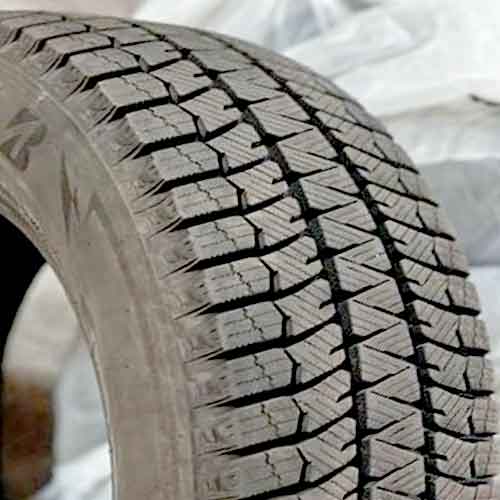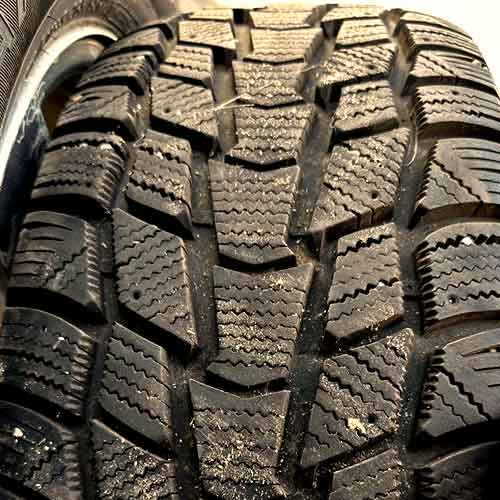Both the Bridgestone Blizzak WS90 and the Mastercraft Glacier Trex, renowned in the world of winter tires, are set head-to-head, each boasting its own distinct capabilities and unique features for tackling challenging weather conditions. Let’s see which tire comes on top.

Table of Contents
Available Sizes
The Bridgestone Blizzak WS90 (review) comes in 52 total sizes in 15 to 19 inches (wheels) with following specs.
- Speed ratings: T or H.
- Load ratings: SL or XL.
- Tread depth: 11 or 12/32″.
- Weight: 17 to 29 lbs.
On the other side, the Mastercraft Glacier Trex comes in 14 to 18″ with following.
- Speed ratings: H and T.
- Load ratings: SL and XL.
- Tread depth: 12 and 14/32″.
- Weight: 15 to 37 lbs.
Tread Appearance
The Bridgestone Blizzak Ws90 features a very powerful directional tread pattern.

The tread actually consist of just 3 ribs, where the middle most is made continuous.
This primary rib is adorned with numerous wave-like sipes, and it also features straight, interconnected sipes that are intricately paired with in-groove notches.
And these notches then join up with the V shaped incisions/openings, facing both sides, laterally, improving overall traction.
Moving towards shoulders, they also get to have notches facing the middle, along with longitudinal slits, which act as in-groove biters.
Additionally, the presence of zigzag-shaped slits further out on the lugs adds another layer of complexity and utility to the design.
On the other hand, Mastercraft Glacier Trex also features a directional design.

Here you get a more open structure of blocks, everywhere. Let me start off from its middle.
So here 3 ribs are seen which form very biting zigzag 4 longitudinal grooves.
The middle most rib has lugs with sharp edges (as they are somewhat arrow shaped), and contain laterally oriented wave-like sipes.
The surrounding ribs have two different types of blocks, and both of them carry multiple-angled siping along with snow vices facing the shoulders. And yes, every other block here also have stud holes for extra icy traction.
The shoulder lugs are pretty much the same, carrying similar features of snow-vices, sipes and stud holes. Though they also features rectilinear sipes, along with interlocking wave-like pattern ones.
Tread Life
Tread life depends on the tire’s weight and tread design.
Having said that, the lighter Bridgestone Blizzak WS90 fares better in terms of tread life. Its lighter structure doesn’t exert a lot force on its rubber, as they rub against the road, hence slowing overall tread burning rate.
On the contrary, the Mastercraft Glacier Trex not only offers a larger weight, but also a more voided up design. So a greater weights here gets divided on a relatively smaller surface area of the rubber.
So each lug getting more pressure on itself, gets to rub off the surface with greater friction.
So comparatively, you get to see an accelerated wear rate on Mastercraft.
Ice Performance
Undeniably, when it comes to ice performance, the Bridgestone Blizzak WS90 sets a benchmark.
And this superiority of this tire, on icy terrains, can be primarily attributed to its unique and complex tread design, which features a blend of varied-sized, angled cuts and V-shaped notches that slant in both directions.
Further enhancing its ice performance is the tread’s siped pattern which significantly improves braking distances and vehicle handling. Basically these sipes are distinctively more aggressive, with more, you can say, biting edges on them, offering enhanced ice gripping capabilities.
On the other side, the Mastercraft Glacier Trex struggles slightly with icy conditions due to its larger tread voids and fewer notches.
Its primary tread area finds it difficult to maintain a sturdy grip on compacted ice, while its shortage of multi-directional sipes reduces its overall ice performance.
However, it’s worth noting that the Mastercraft Glacier Trex does provide studdable lugs for improved traction on extremely icy surfaces.
Still, in the absence of studs, the Blizzak WS90 dominates when it comes to icy conditions.
Dry Traction
Transitioning to dry conditions, the Blizzak WS90 shines in terms of both directional grip and handling, the two crucial aspects of overall dry performance.
In terms of grip, which is heavily influenced by the central area of the tread, the Blizzak yields a streamlined, continuous rib design that offers a consistent contact patch with the road, facilitating faster braking and acceleration.
Furthermore, when it comes to handling, which depends on the tire’s shoulders, it presents more closely spaced lateral voids there, that improve the rubber-to-road contact during cornering.
In comparison, the Mastercraft Glacier Trex, besides having wider grooves, carries more weight, which can increase lug movement during cornering, thereby reducing steering feedback and adversely impacting handling.
Thus, in dry conditions, the Blizzak maintains an edge.
Wet Traction
The ability of a tire to grip in wet conditions is largely influenced by its tread design and rubber compound. In this aspect, despite both the Bridgestone Blizzak WS90 and its competitor featuring substantial siping and soft, thermally adaptive rubbers, the former edges out the latter. Let me explain why.
The function of sipes is primarily to push air out and draw water particles in. And Blizzak with its dual siping system, which includes a blend of aggressive interlocking and rectilinear designs, you get a much better wet griping abilities.
Furthermore, you also get multi angled sipes on this tire too, and those offer a more effective cornering abilities, as you get a grip in all directions, with them.
In contrast, the Mastercraft Glacier Trex, you get siping which adopts a different methodology, with a purely lateral orientation, leading to a different traction outcome.
Though, its performance is notably commendable in hydroplaning resistance, as it gave out greater float speeds in both curved and straight aqua tests.
Float speed is just how fast a tire can go over standing water.
So to summarize here, the Mastercraft is a better pick when it comes to hydroplaning, while the Blizzak does better in the wet gripping section.
Snow Performance
When it comes to negotiating snow-laden terrains, both tires perform exceptionally well, notwithstanding the distinctive challenges different types of snow pose.
Nonetheless, I’d still go here with Mastercraft, as this tire offers a better tread pattern for this terrain type.
It features a more assertive directional tread pattern, complemented by lugs having spacious structures, where the loose fluffy snow particles are easily captured.
And helping to that are the tires numerous snow vices and interlocking grooves.
This trapped snow offers a better gripping contact on the ground, as snow stick better on itself compared to rubber.
In comparison, the Bridgestone Blizzak WS90’s design is more compact, even though it, too, boasts a continuous running central rib.
And in addition, its absence of an interlocking groove structure prevents the tire from gathering as much snow as its rival, resulting in a somewhat diminished performance in snowy conditions.
Therefore, in terms of snow performance, the Mastercraft Glacier Trex holds a distinct advantage.
Ride Comfort
The comfort of a ride offered by a tire is a finely tuned balance between various factors including road noise, vibration absorption, the tire’s tread pattern, and its sidewall design.
When it comes to tread noise, the Bridgestone Blizzak WS90 secures a slight advantage, attributable to its less voided tread design.
This design configuration reduces the volume of air able to enter and move around, which in turn lowers noise generation.
And adding to overall comfort, it its lighter structure which gives you better response times, so you get an overall smoother and more refined ride compared to its competitor.
On the other hand, the Mastercraft Glacier Trex, although lacks in noise, and road smoothness, it does offer one area of supremacy with its softer rubber compound.
This rubber composition excels in cushioning against road irregularities, providing a noticeable difference in ride comfort compared to the Blizzak WS90.
Fuel Efficiency
Fuel efficiency in a tire is intrinsically associated with traction and structural weight, both of which impact the tire’s rolling resistance.
To simplify, the heavier the tire and the larger the tread voids, the more the tire lugs flex during cornering, braking, or acceleration.
This flexing or deformation of the lugs leads to increased energy expenditure, a characteristic observed with the Mastercraft Glacier Trex.
In stark contrast, the Blizzak WS90, engineered with streamlined, longitudinally aligned ribs, minimizes rolling resistance. This effectively leads to better fuel efficiency, giving you more miles per gallon with the Blizzak WS90.
Summing Up
So what’s the verdict? Well it all hinges on the following key points.
The Bridgestone Blizzak WS90 displays remarkable performance on icy surfaces and provides exceptional traction in dry conditions, largely due to its detailed biting edges and unbroken center rib.
It also offers superior fuel efficiency, thanks to its lighter weight and aerodynamic design, and it outperforms in wet traction and road quietness.
In contrast, the Mastercraft Glacier Trex shines on snowy terrains and in vibration absorption, owing to its open tread pattern and effective shock-absorbing design.
While its heavier weight leads to quicker tread wear and lesser fuel efficiency, its performance on snow-covered surfaces and the comfort it provides on uneven roads are noteworthy.
Ultimately, the selection between the two would depend on the specific driving conditions and personal preferences of the driver.